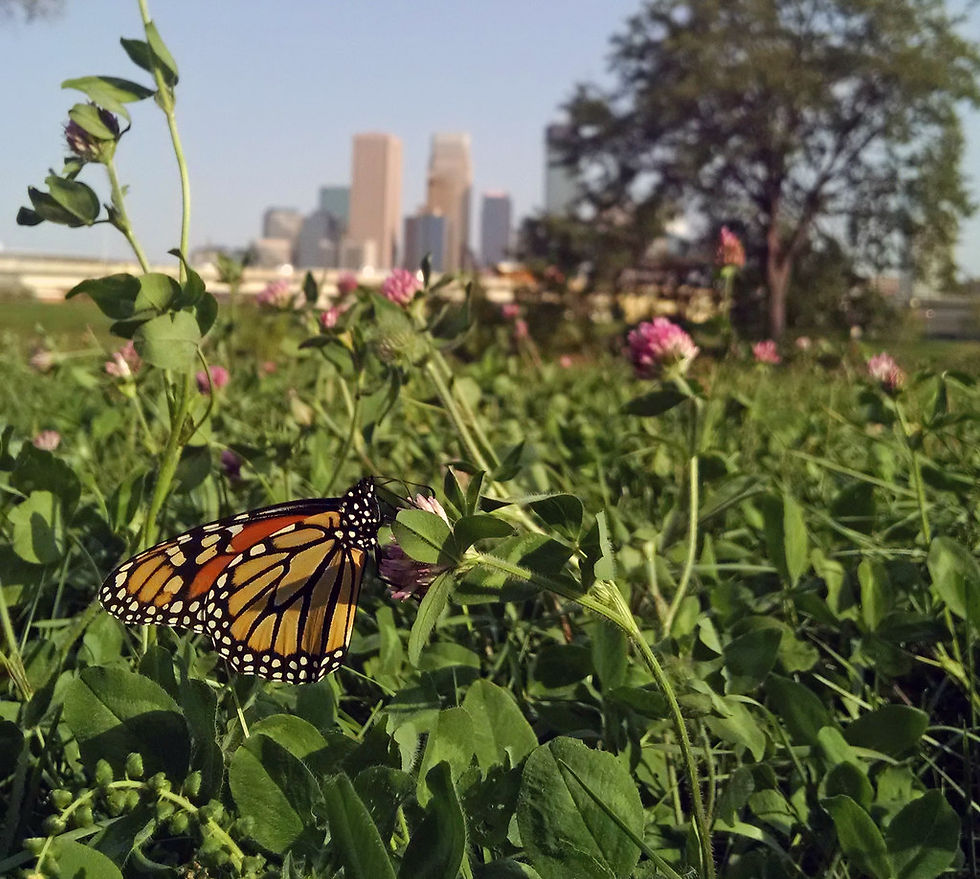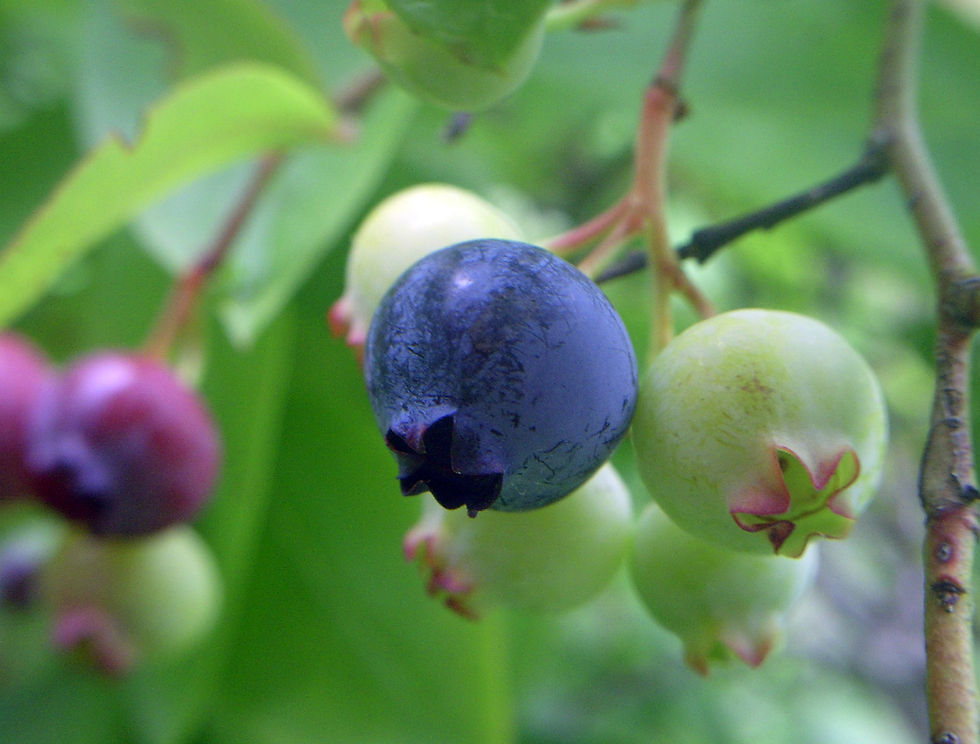Habitat for Monarchs
- Jennifer Anderson

- Mar 17, 2024
- 4 min read

Whatever I’m doing in the garden, I have to stop, stare and sometimes grab my camera whenever a Monarch Butterfly comes near.
All butterflies are beautiful. But it’s the mystique of the annual migration – what the U.S. Fish and Wildlife Service calls “the most spectacular in the insect world” – that adds to the thrill of seeing the Monarchs.


On the East Coast, that migration begins in summer as far north as Canada. The adults just arriving from Mexico lay their eggs on the milkweed plants, and then they fade away, their short lives coming to a close.
By late August, after the caterpillars have hatched and morphed into butterflies the great migration begins. The new Monarchs have never been to Mexico, but somehow they know where to go and how to get there.
Most East Coast migrants end up wintering in the forests in the Sierra Madre Mountains. A single Monarch may travel 100 miles in a single day, sometimes at elevations of 1,000 feet or higher, to make this journey.

As they travel, they look for friendly habitats to rest and fuel up, preferring gardens with milkweed plants.
A Species in Trouble
Finding that habitat has become difficult as heavy pesticide use, housing developments, urban sprawl, shopping malls and agriculture have taken hundreds of millions of acres.

From the mid-1990s to 2020 the eastern population of Monarch Butterflies has dropped 88 percent, from an estimated 380 billion to just under 45 million.
A lot of organizations and government agencies have banded together to try to help the Monarchs. Among them is the Monarch Joint Venture, a collaboration of federal and state agencies, organizations, businesses and academics.

Through education, outreach and other initiatives they have increased awareness of the plight of the Monarchs and encouraged habitat creation.
What You Can Do
Building a Monarch habitat is as simple as planting a wildflower garden in a sunny spot in your yard. The key, though, is to incorporate a lot of milkweed plants, at least 10 or more for a 100-square-foot garden.

Among milkweed plants native to New England, Butterfly Milkweed, Asclepias tuberosa, and Swamp Milkweed, Asclepias incarnata, tend to work best in garden settings.
One option is to plant 5 of each. Another would be to plant just one type of milkweed but up the quantity to 15.

Once your milkweeds are set you will need an array of other plants that provide the nectar Monarchs need for survival.
Since you’ll want to allow for 12- to 18-inch spacing between plants, and you already have 10 or 15 milkweeds, you’re looking for an additional 30 to 40 plants.
Easy Garden Plants
There are tons to choose from. One tip when planting perennials is to choose plants that bloom at different times so you have color all season long.
Below are a bunch of suggestions broken down by month. All of these plants attract butterflies and other pollinators. Larval host plants are identified.

April
Golden Alexander, Zizia aurea, (above) is going to be one of your earliest bloomers, with bright yellow flowers popping in April and lasting through June. Golden Alexander is a larval host to the beautiful Black Swallowtail.

May
Another early bloomer is Wild Lupine, Lupinus perennis, flowering in May through summer. This beautiful plant has long stalks of lovely lavender flowers. It’s well behaved in the garden and is a larval host to the Karner Blue.
Other early bloomers are the Baptisias: Wild Blue Indigo, Baptisia australis, blooming in May, and Yellow Wild Indigo, Baptisia tinctoria, opening in June. Both will bloom all summer long.

Wild Blue Indigo is a larval host to the Wild Indigo Duskywing and several other butterflies. Yellow Wild Indigo is a larval host to the Pearl Crescent.

July
By mid-summer the options can become overwhelming. Here are four that are relatively easy to grow:
Purple Coneflower, Echinacea purpurea, and Sweet Joe Pye Weed, Eutrochium purpureum, are stunning plants that bloom from July through September, with Sweet Joe blooming pink and lavender. Purple Coneflower supports the Silvery Checkerspot and other butterflies.


Another fun plant, Turtlehead, Chelone glabra, is an adorable plant with a bud that looks a little like a turtle. You’ll have these creamy white blooms through September. Turtlehead attracts hummingbirds and is a larval host to the Baltimore Checkerspot.
A bit longer lasting are Black-eyed Susans, Rudbeckia hirta, offering cheerful yellow rays with black centers through October. Black-eyed Susans support the Wavy-lined Emerald and Silvery Checkerspot butterflies.


September
For fall, bring on the Asters! One of my favorites is Smooth Aster, Symphyotrichum laeve, because it’s not only beautiful but also well behaved. Its flowers are purple with yellow centers and will light up the garden from September through October, providing critical late-season nectar.

Smooth Aster also hosts the Silvery Checkerspot and Pearl Crescent.
Other excellent choices are New England Aster, Symphyotrichum novae-angliae, one of the tallest and purplist of the asters, and New York Aster, S. novi-belgii, shorter and bushier with light purple blooms
Groundcovers
Once you’ve chosen your 35 to 40 plants, you’ll want a groundcover.
Groundcovers not only provide additional color, but they also add greenery and generally replace mulch, which does not provide much ecological benefit.
Groundcovers should be low to the ground and spread easily. Here are some possibilities:

Pussytoes, Antennaria plantaginifolia, produces puffy white flowers beginning in March and lasting all spring. After the flowers fade you have a mat of green with Pussytoes’ semi-evergreen florets. Pussytoes also is a larval host to the American Lady and other butterfly species.


Wild Strawberry, Fragaria virginiana, provides the most delicious of all the native fruits. It tops out at just 6 inches with tiny white flowers blooming in March or April and berries lasting all summer.
Stonecrop, Sedum ternatum, forms an evergreen mat of solid green with white star-shaped flowers blooming in early summer. It gets only 2 to 3 inches tall, avoiding competition with the surrounding flowers.

Once you get your plants, place them on your garden, still in the pots, and experiment with different arrangements, keeping in mind height, color and bloom time.
Happy Planting!
About the author:

Jennifer Anderson is the owner of Tree Talk Natives, a native tree and plant nursery in Rochester, Mass. She loves to talk native plants and can be reached at jennifer@treetalknatives.com.
Sources:
About Us. Monarch Joint Venture.
Howard, I and Kailee Slusser. 5 Monarch Migration Facts. Xerces Society. October 10, 2023
The Monarch Butterfly in North America. US Forest Service.





Comments